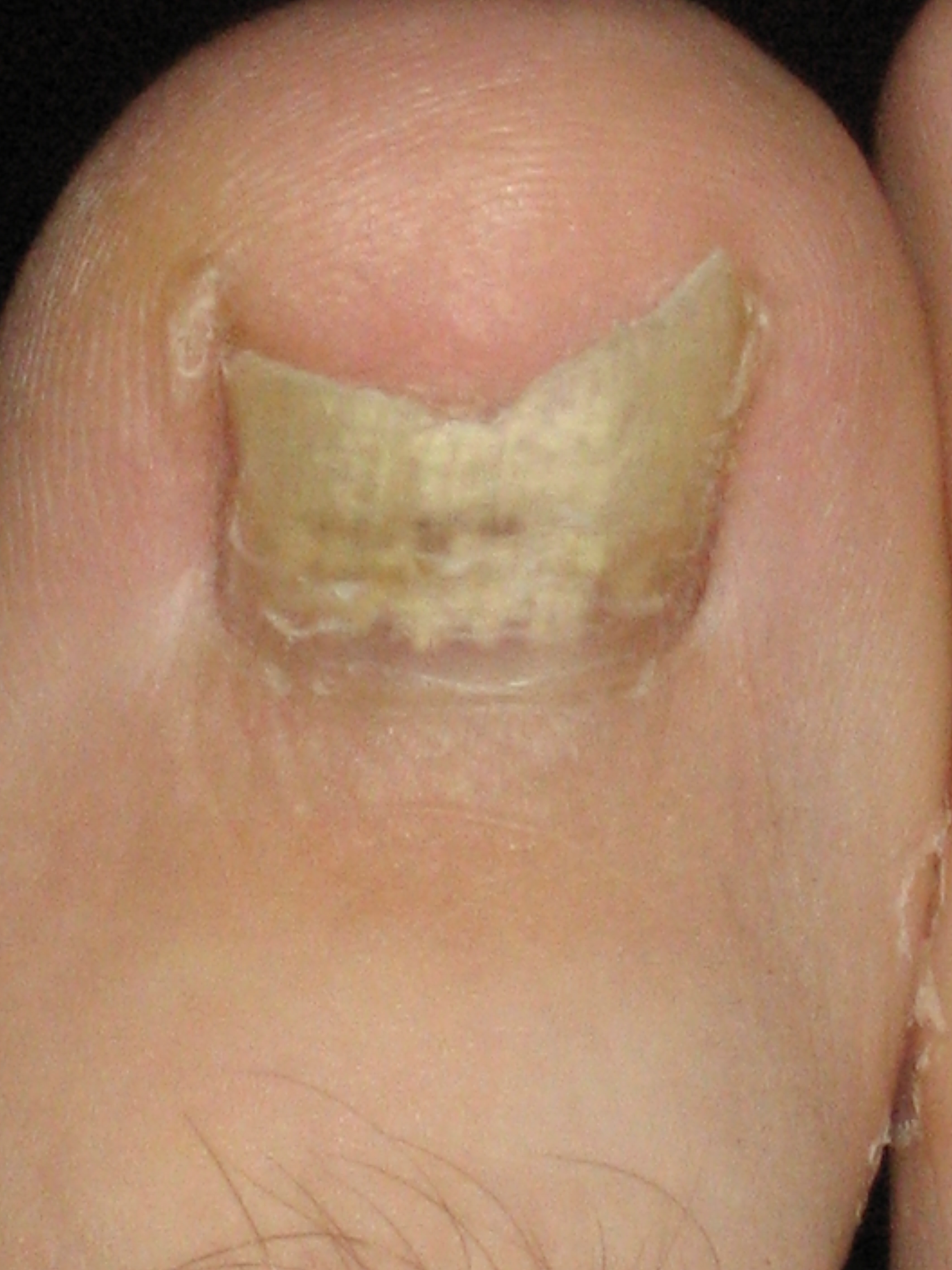|
Nail Fungus
Onychomycosis, also known as tinea unguium, is a fungal infection of the nail. Symptoms may include white or yellow nail discoloration, thickening of the nail, and separation of the nail from the nail bed. Fingernails may be affected, but it is more common for toenails. Complications may include cellulitis of the lower leg. A number of different types of fungus can cause onychomycosis, including dermatophytes and ''Fusarium''. Risk factors include athlete's foot, other nail diseases, exposure to someone with the condition, peripheral vascular disease, and poor immune function. The diagnosis is generally suspected based on the appearance and confirmed by laboratory testing. Onychomycosis does not necessarily require treatment. The antifungal medication terbinafine taken by mouth appears to be the most effective but is associated with liver problems. Trimming the affected nails when on treatment also appears useful. There is a ciclopirox-containing nail polish, but there is no ... [...More Info...] [...Related Items...] OR: [Wikipedia] [Google] [Baidu] |
Infectious Disease (medical Specialty)
Infectious diseases (ID), also known as infectiology, is a medical specialty dealing with the diagnosis and treatment of infections. An infectious diseases specialist's practice consists of managing nosocomial (Hospital-acquired infection, healthcare-acquired) infections or community-acquired infections. An ID specialist investigates and determines the cause of a disease (bacteria, virus, parasite, fungus or prions). Once the cause is known, an ID specialist can then run various tests to determine the best drug to treat the disease. While infectious diseases have always been around, the infectious disease specialty did not exist until the late 1900s after scientists and physicians in the 19th century paved the way with research on the sources of infectious disease and the development of vaccines. Scope Infectious diseases specialists typically serve as consultants to other physicians in cases of complex infections, and often manage patients with HIV/AIDS and other forms of immuno ... [...More Info...] [...Related Items...] OR: [Wikipedia] [Google] [Baidu] |
Fusarium
''Fusarium'' (; ) is a large genus of filamentous fungi, part of a group often referred to as hyphomycetes, widely distributed in soil and associated with plants. Most species are harmless saprobes, and are relatively abundant members of the soil microbial community. Some species produce mycotoxins in cereal crops that can affect human and animal health if they enter the food chain. The main toxins produced by these ''Fusarium'' species are fumonisins and trichothecenes. Despite most species apparently being harmless (some existing on the skin as commensal members of the skin flora), some ''Fusarium'' species and subspecific groups are among the most important fungal pathogens of plants and animals. The name of ''Fusarium'' comes from Latin ''fusus'', meaning a spindle. Taxonomy The taxonomy of the genus is complex. A number of different schemes have been used, and up to 1,000 species have been identified at times, with approaches varying between wide and narrow concep ... [...More Info...] [...Related Items...] OR: [Wikipedia] [Google] [Baidu] |
Itch
An itch (also known as pruritus) is a sensation that causes a strong desire or reflex to scratch. Itches have resisted many attempts to be classified as any one type of sensory experience. Itches have many similarities to pain, and while both are unpleasant sensory experiences, their behavioral response patterns are different. Pain creates a withdrawal reflex, whereas itches leads to a scratch reflex. Unmyelinated nerve fibers for itches and pain both originate in the skin. Information for them is conveyed centrally in two distinct systems that both use the same nerve bundle and spinothalamic tract. Classification Most commonly, an itch is felt in one place. If it is felt all over the body, then it is called ''generalized itch'' or ''generalized pruritus''. Generalized itch is infrequently a symptom of a serious underlying condition, such as cholestatic liver disease. If the sensation of itching persists for six weeks or longer, then it is called ''chronic itch'' or ''c ... [...More Info...] [...Related Items...] OR: [Wikipedia] [Google] [Baidu] |
Rash
A rash is a change of the skin that affects its color, appearance, or texture. A rash may be localized in one part of the body, or affect all the skin. Rashes may cause the skin to change color, itch, become warm, bumpy, chapped, dry, cracked or blistered, swell, and may be painful. The causes, and therefore treatments for rashes, vary widely. Diagnosis must take into account such things as the appearance of the rash, other symptoms, what the patient may have been exposed to, occupation, and occurrence in family members. The diagnosis may confirm any number of conditions. The presence of a rash may aid diagnosis; associated signs and symptoms are diagnostic of certain diseases. For example, the rash in measles is an erythematous, morbilliform, maculopapular rash that begins a few days after the fever starts. It classically starts at the head, and spreads downwards. Differential diagnosis Common causes of rashes include: * Food allergy * Medication side effects * Anxiety ... [...More Info...] [...Related Items...] OR: [Wikipedia] [Google] [Baidu] |
Skin Lesions
A skin condition, also known as cutaneous condition, is any medical condition that affects the integumentary system—the organ system that encloses the body and includes skin, nails, and related muscle and glands. The major function of this system is as a barrier against the external environment. Conditions of the human integumentary system constitute a broad spectrum of diseases, also known as dermatoses, as well as many nonpathologic states (like, in certain circumstances, melanonychia and racquet nails). While only a small number of skin diseases account for most visits to the physician, thousands of skin conditions have been described. Classification of these conditions often presents many nosological challenges, since underlying causes and pathogenetics are often not known. Therefore, most current textbooks present a classification based on location (for example, conditions of the mucous membrane), morphology ( chronic blistering conditions), cause (skin conditions resul ... [...More Info...] [...Related Items...] OR: [Wikipedia] [Google] [Baidu] |
Dermatophytids
Dermatophytids are fungus-free disseminated skin lesions resulting from induced sensitization in patients with ringworm infections. See also * Candidid * Skin lesion A skin condition, also known as cutaneous condition, is any medical condition that affects the integumentary system—the organ system that encloses the body and includes skin, nails, and related muscle and glands. The major function of this ... References External links {{Cutaneous-condition-stub} Animal fungal diseases Mycosis-related cutaneous conditions ... [...More Info...] [...Related Items...] OR: [Wikipedia] [Google] [Baidu] |
Psychosocial
The psychosocial approach looks at individuals in the context of the combined influence that psychological factors and the surrounding social environment have on their physical and mental wellness and their ability to function. This approach is used in a broad range of helping professions in health and social care settings as well as by medical and social science researchers. Background Psychiatrist Dr. Adolf Meyer in the late 19th century stated that: "We cannot understand the individual presentation of mental illness, nd perpetuating factorswithout knowing how that person functions in the environment." Psychosocial assessment stems from this idea. The relationship between mental and emotional wellbeing and the environment was first commonly applied by Freudian ego-psychologist Professor Erik Erikson in his description of the stages of psychosocial development in his book called Childhood and Society in 1950. Mary Richmond considered there to be a strict relationship betwe ... [...More Info...] [...Related Items...] OR: [Wikipedia] [Google] [Baidu] |
Advanced Onychomycosis
The Advanced Party (), otherwise known as the Advanced Association () was a liberal and centrist Zionist political association in Mandatory Palestine founded by several urban liberal Zionists. The party was founded in order to represent the voice of Tel Aviv liberals and Zionists in the election to the Yishuv's Assembly of Representatives in 1920. The party placed sixth in the election, coming in behind their rural General Zionist counterrpart, Hitahdut HaIkarim. The party represents first formal General Zionist political party to be founded, and as one of the earliest political ancestors of the modern-day Likud. History Under the British Mandate, the Yishuv (Jewish community), established a network of political and administrative institutions, among them the Assembly of Representatives.Itamar Rabinovich & Jehuda Reinharz (2008''Israel in the Middle East''Brandeis University Press, p84 To ensure that small groups were properly represented, a system of proportional representation ... [...More Info...] [...Related Items...] OR: [Wikipedia] [Google] [Baidu] |
Georg Meissner
George Meissner (19 November 1829 – 30 March 1905) was a German anatomist and physiologist born in Hanover. He studied medicine at the University of Göttingen, where he worked closely with Rudolf Wagner (1806–1864). In 1851 he accompanied Wagner and Theodor Billroth (1829–1894) on an expedition to Trieste, where he performed scientific studies of torpedo fish. In 1852 he earned his doctorate at Göttingen, and was later a university professor at Basel (from 1855), Freiburg (from 1857) and Göttingen (1860–1901). His name is associated with Meissner's corpuscles, which are mechanoreceptors that are responsible for sensitivity to light touch. They were first described in 1852, with Meissner and Wagner each feeling that he alone should be given priority as to discovery of the corpuscles. A controversy took place between the two men, causing a strained relationship that lasted for several years. His name is also associated with Meissner's plexus, being described as ... [...More Info...] [...Related Items...] OR: [Wikipedia] [Google] [Baidu] |
Nail Polish
Nail polish (also known as nail varnish in British English or nail enamel) is a lacquer that can be applied to the human Nail (anatomy), fingernails or toenails to decorate and protect the nail plates. The formula has been revised repeatedly to enhance its decorative properties, to be safer for the consumer to use, and to suppress cracking or peeling. Nail polish consists of a mix of an organic polymer and several other components that give it colors and Surface texture, textures. Nail polishes come in all color shades and play a significant part in manicures and pedicures. History Nail polish originated in China and dates back to 3000 BCE. Around 600 BCE, during the Zhou dynasty, the royal house preferred the colors gold and silver. However, red and black eventually replaced these metallic colors as royal favorites. During the Ming dynasty, nail polish was often made from a mixture that included beeswax, egg whites, gelatin, vegetable dyes, and gum arabic. In Ancient Egypt, ... [...More Info...] [...Related Items...] OR: [Wikipedia] [Google] [Baidu] |
Liver Problems
Liver disease, or hepatic disease, is any of many diseases of the liver. If long-lasting it is termed chronic liver disease. Although the diseases differ in detail, liver diseases often have features in common. Liver diseases File:Ground glass hepatocytes high mag cropped 2.jpg, Ground glass hepatocytes File:Primary biliary cirrhosis intermed mag much cropping.jpg, Primary biliary cirrhosis File:Buddchiari2.PNG, Budd–Chiari syndrome File:Non-alcoholic_fatty_liver_disease1.jpg, Micrograph of non-alcoholic fatty liver disease There are more than a hundred different liver diseases. Some of the most common are: * Fascioliasis, a parasitic infection of liver caused by a liver fluke of the genus '' FascioIa'', mostly '' FascioIa hepatica''. * Hepatitis, inflammation of the liver, is caused by various viruses ( viral hepatitis) also by some liver toxins (e.g. alcoholic hepatitis), autoimmunity ( autoimmune hepatitis) or hereditary conditions. * Alcoholic liver disease is a h ... [...More Info...] [...Related Items...] OR: [Wikipedia] [Google] [Baidu] |




